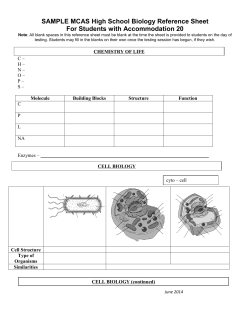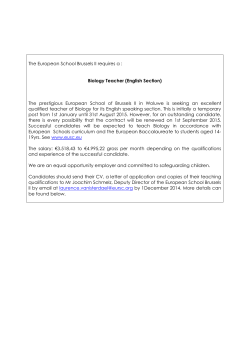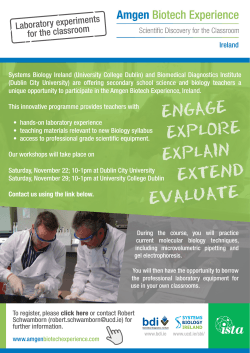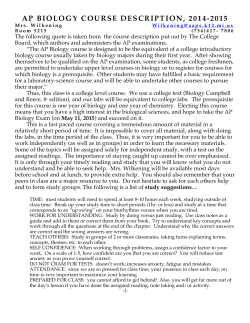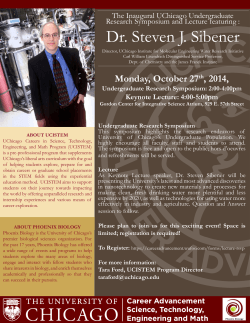
Presented at UBCO’s 10 Annual Learning Conference, May 7-8, 2014
Presented at UBCO’s 10th Annual Learning Conference, May 7-8, 2014 Elizabeth Rennie, Instruction & Outreach Librarian Susan Purdy, Lecturer Department of Biological Sciences Biology 1210 is a second semester First Year Biology majors’ course, ~ 250 students in 12 lab sections. In the past students were required to do a library assignment as part of the lecture component. Students requested library assistance on a voluntary basis, at the Reference Desk. Relate abstract concepts in biology to realworld situations, and make biology content relevant Engage students as active participants Stimulate the curiosity students have about learning for the natural world Integrate multiple forms of assessment to track student learning Introduce fewer concepts, but present them in greater detail Ensure that courses are active, outcome orientated, inquiry driven and relevant Based on the “There’s a Heifer in Your Tank” project developed by Dr. Frank Robinson at the University of Alberta, Agriculture Science program. By posing ‘quirky questions’ teams of students went about answering them using videos. Two years ago we introduced our version with the first quirky question being ‘Why is there a salmon in the tree’? Find, differentiate and correctly use academic information sources Communicate biological concepts effectively – both in writing and verbally Form contacts with other Biology faculty / learn about their research or else other biological research happening currently Learn to work cooperatively in teams Develop a sense of community in first year Biology students Groups – must be properly formed and managed Accountability – students must be accountable for the quality of their individual and group work Feedback – must be frequent and timely Assignment design – group assignments must promote both learning and team development “With a group, the whole is often equal to or less than the sum of its parts; with a team, the whole is always greater” Forming teams ◦ Include students with diverse ability levels ◦ Avoid isolating at-risk minority students ◦ Minimum 3, maximum 5 (although TBL recommends 5 to 7) ◦ Reform teams for new projects? Establishing expectations ◦ Team policy statement / team expectations agreement Dealing with problem team members ◦ Evaluation of team functioning – part-way through the project ◦ Peer Ratings Why does dwarf mistletoe resemble a cannon? Why would a black bear and a squirrel make poor bed mates? How does a Vancouver Island marmot find a date these days? Why are bluebirds blue? Why does this flower smell like a rotting corpse? How do Canadian monarchs find their way to Mexico? Why do female hyenas have a penis? Will adding iron to the ocean help the planet escape from heating up? Introduce the project, choose questions and teams Library session Team Bibliography Teams develop videos (4-5 min in length) to answer their question. Must use accurate and complex scientific content but be entertaining Prepare an individual article Librarians teach twelve 3-hour lab sections in one week Each session includes: ◦ An overview of the Team Bibliography assignment ◦ A group exercise evaluating resources, practicing the process they’ll need to apply in their assignment ◦ Demonstration searches to find different resources ◦ Getting set up in RefWorks ◦ Approximately 2 hours of hands-on group research time, with librarian assistance as required Several of the SITT Learning Outcomes match those of the Library Instruction Program. This in itself isn’t unique; the library attempts to conduct most library instruction sessions in a lab environment in order to give students direct active learning experiences. BIOL 1210 is, however, one of the more successful library instruction collaborations. 3-hour time period Assignment timelines: Bibliographies are due the following week The Bibliography is a TEAM assignment Nursing (and why that worked) Arts (why it didn’t work, and how it might) The SITT assignment required making significant changes to the BIOL 1210 labs Student feedback, however, indicates that most students found the assignment to be enjoyable and engaging – and that they found the library session to be useful. useful for learninmg how to find information sources useful for learning to Disagree differentiate bewteen Neutral information sources Agree useful for learning the CSE citation style 0 20 40 60 80 I would prefer to work on my own for this… I enjoyed the collaborative nature… Disagree I felt my team was Neutral just the right size Agree I felt my team functioned well 0 50 100 Students rated their peers in 5 categories (Van den Bogaard, 2007) ◦ ◦ ◦ ◦ ◦ Job performance Attitude and interaction with team members Leadership and initiative Team meetings and time management Communication within the team and for the project Excellent – 100 Good – 87 Satisfactory – 75 Ordinary – 63 Marginal – 50 Poor – 25 Nothing - 0 Only multiply up to 1.05 I did like to have a chance to do a team -eval part way through the project Disagree Neutral I thought the peer- Agree evaluation process was fair 0 20 40 60 80 I felt I learned a lot about the topic Disagree Library session useful for differentiating… Neutral Library session useful Agree for learning CSE style Library session was useful in learning… 0 50 100 Overall I enjoyed this project Disagree I would recommend Neutral this project be used Agree again 0 20 40 60 80 100 “I did not enjoy this project!” “Thank you! Very fun learning the topic this way!” “It was an interesting way to develop knowledge on biology subjects.” “Good way to learn in groups – seemed scary at first, but overall a good experience.” Provide students with real-world questions Provide opportunities for group work, balanced by individual assignments Consider creative assignment options (such as videos), accompanied by clear grading rubrics outlining assignment expectations Be willing to consider experiential exercises that teach group work, critical thinking, verbal communication, creative problem-solving, etc. – even at the expense of (some) discipline-specific content. Collaborate with a librarian, well in advance Consider how to make hands-on research time immediately relevant Consider how to encourage students to stick around for hands-on research time: groups, partnered exercises, etc. Think about how much time you can reasonably devote (and whether that’s enough for students to be able to meet your expectations) http://demo.firepad.io/#17Qt56jlKa http://qikpad.co.uk/p/b1EWPbr41S http://collabedit.com/be3fr How and why did the hummingbird cross the Gulf of Mexico? http://youtu.be/vmBROO8ZyQ8 How are leaf cutter ants good farmers? http://youtu.be/m19TEDOMDq8 Why have male fish living downstream from big cities switched their sex? http://www.youtube.com/watch?v=7mP0ZA9_ MJg AAAS. 2009. Vision and change in undergraduate biology education – a call for action. Final Report of a National Conferences organized by the American Association for the Advancement of Science. Oakley B, Felder RM, Brent R, Elhajj I. 2004. Turning student groups into effective teams. J Student Centered Learning: 2 (1) 9-28 Van den Bogaard ME, Saunders-Smits GN. 2007. Peer and self evaluations as means to improve the assessment of project based learning. Proceedings from 37th ASEE/IEEE Frontiers in Education Conference, Milwaukee, WI Michaelsen, LK & M Sweet. 2008. The essential elements of team based learning. New Direction for Teaching and Learning 116: 7-27 ACRL… Elizabeth Rennie, erennie@tru.ca Susan Purdy, spurdy@tru.ca
© Copyright 2025


